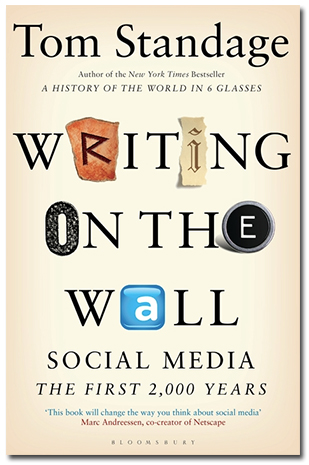Writing on the Wall, review: Social media is nothing new

Tom Standage, an editor at The Economist, likes to prove there is nothing new under the sun. In other words, he studies historical parallels to phenomena that our arrogant chronocentrism presumes are utterly new experiences for the human race. His first book, The Victorian Internet, compared the development of the internet with the advent of the electric telegraph. His latest, Writing on the Wall: Social Media - The First 2,000 Years, finds the workings of social media in Roman times, when an author writing a book would deliver a copy to the home of the most influential person with the biggest library. People could go there to read the book, or make their own copies for others in turn to read or copy further.

At the same time and in the same era, gossip was crucial, as Standage learns from studying Cicero's letters. Like a Twitterer today, Cicero might receive and respond to dozens of letters a day, quoting one to another and adding or eliciting further commentary and transmitting them through what Standage calls the Roman version of broadband: slaves whose only job was to carry and deliver messages.
Move ahead a thousand-plus years into mediaeval Europe. Martin Luther posts his list of 95 propositions for discussion on the door of the castle church in Wittenberg. From there it's copied and distributed. We laugh at the temporal dissonance when Standage calls this process "going viral". But after two weeks in which the printers distributed the mass copies they made, all of Germany knew Luther's complaints. Isn't 'going viral' exactly what that is? And doesn't it all sound terribly familiar?
Coffehouse culture
Standage's romp through history includes the coffeehouses of 17th- and 18th-century Europe, where all sorts of intellects gathered to share ideas and news. Often, these establishments became specialised — one saw gatherings discussing science, another poetry, for example — in a meritocracy of ideas rather than of persons (a reason why Charles II wanted to shut them down in 1675). Dismissed irritably by some as a trivial waste of time, coffeehouses were the crucible of the ideas that became the scientific revolution.
In our history-disrespecting time, it's fashionable to think that social media are new media, and 'old media' was always the way of the world. In Standage's longer view, mass media, as formulated in the last 150 years, is the anomaly. Restricting copying made no sense when it took the best scribes weeks to make a single copy; it only matters now, when the investment required to buy and operate expensive mass-production machines is suddenly being challenged by new means of distribution with negligible costs of entry.
In writing his book, Standage needed a working definition of social media. Here's what he came up with, as he explained it at the end of October at The Future of Text: "Social media is media you get from other people, exchanged along social connections, and creating a distributed discussion or community". That's us, isn't it? But it's also all those other societies Standage visits in the book. Why did we forget? Machines created broadcasters and publishers — and turned us into consumers. The Romans would have understood us better than Rupert Murdoch does.
Writing on the Wall: Social Media - the First 2,000 Years
By Tom Standage
Bloomsbury
278 pages
ISBN: 978-1-4088-4206-5
£14.99